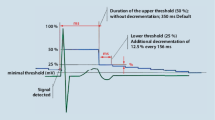Summary
The high incidence of inappropriate therapies due to supraventricular tachycardia remains a major unsolved problem of the implantable cardioverter defibrillator. A new morphology discrimination (MD) algorithm has been introduced to improve specificity of ICD therapy without loss of sensitivity. It was the aim of this study to systematically analyze sensitivity and specificity of the MD criterion in combination with the enhanced detection criteria sudden onset and rate stability in the detection of ventricular and supraventricular tachycardia.
After ICD implantation in 259 patients, 787 detected episodes in 74 patients with available stored electrograms were documented during a follow-up period of 359±214 days. With a nominal programming of the MD algorithm at ≥60%, sensitivity and specificity for all episodes were 82.6%/77.2%. For sinus tachycardia, atrial fibrillation and atrial flutter the specificities were 80.6%, 69.6% and 75%, respectively. In patients with primarily appropriate MD detection, sensitivity and specificity significantly improved to 95.8%/91.7%. Programming the sudden onset criterion with <100ms and the stability criterion with <50ms, sensitivity and stability of the combined application of the MD algorithm and sudden onset and MD algorithm and stability were 96.2%/52.2% and 94.4%/63.8%, respectively.
The MD criterion in combination with other enhanced detection criteria might significantly improve specificity of tachyarryhthmia detection of ICD therapy.
Zusammenfassung
Inadäquate Therapien implantierbarer Kardioverter-Defibrillatoren infolge supraventrikulärer Tachykardien stellen weiterhin die häufigste Komplikation der ICD-Therapie dar. Die Einführung des Morphologie (MD)-Kriteriums verspricht eine Verbesserung der Spezifität in der Tachyarrhythmieerkennung bei Erhalt der Sensitivität. Ziel dieser multizentrischen Studie war die systematische Analyse von Sensitivität und Spezifität des MD-Kriteriums in kombinierter Anwendung mit den Kriterien Stabilität und Frequenzsprung (Sudden Onset) bei spontanen Episoden ventrikulärer und supraventrikulärer Tachykardien.
Bei 259 Patienten wurden nach ICD-Implantation 787 gespeicherte Episoden bei 74 Patienten mit erhältlichem Speicherelektrogramm während einer Nachbeobachtungszeit von 359±214 Tagen analysiert. Bei nominaler Programmierung des MD-Kriteriums mit ≥60% ergaben sich unter Berücksichtigung aller Episoden eine Sensitivität/Spezifität der Detektion von 82,6%/77,2%. Bei getrennter Analyse von Sinustachykardien, Vorhofflimmern und Vorhofflattern betrug die Spezifität 80,6%, 69,6% und 75%. Bei Patienten mit primär adäquater MD-Detektion waren Sensitivität und Spezifität mit 95,8%/91,7% deutlich verbessert. Bei nominaler Programmierung des Sudden Onset-Kriteriums mit <100ms und des Stabilitätskriteriums mit <50ms ergaben sich für die Kombination MD- und Sudden-Onset-Kriterium bzw. MD- und Stabilitätskriterium eine Sensitivität/Spezifität von 96,2%/52,2% bzw. 94,4%/63,8%.
Die Anwendung des MD-Detektionskriteriums lässt in der kombinierten Anwendung mit den herkömmlichen erweiterten Kriterien wie Sudden Onset- und Stabilitätskriterien eine deutlich verbesserte Spezifität der ICD-Therapie erwarten.
Similar content being viewed by others
Author information
Authors and Affiliations
Additional information
Eingegangen: 23. März 2000 / Akzeptiert: 25. Mai 2000
Rights and permissions
About this article
Cite this article
Korte, T., Trappe, H.J., Grönefeld, G. et al. Neues ICD-Morphologie-Kriterium zur Differenzierung supraventrikulärer und ventrikulärer Tachykardien. Z Kardiol 89, 1019–1025 (2000). https://doi.org/10.1007/s003920070154
Issue Date:
DOI: https://doi.org/10.1007/s003920070154




